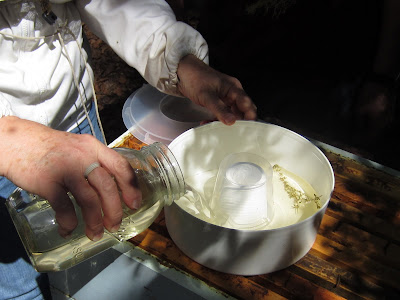We opened my struggling hive at Blue Heron today to find that it was still in terrible shape despite the combination of the two struggling hives and the installation of the very sparse nuc that we got late in the summer.
The top box was empty of supplies and brood - just empty comb.


In the second box, the bees only covered about three frames. Pitiful.

I have a new camera that I am not very pleased with so the pictures of the brood and larvae we found were not in focus. However, we did see brood and larvae.
Mostly we discussed the possibility of feeding this hive heavily through October and perhaps trying to overwinter it at my house rather than at the Blue Heron in a nuc box rather than in a hive box.




I brought a rapid feeder with me and would have put it over the hole in the inner cover but forgot that this hive had a ventilated hive cover (note to self: replace with solid cover ASAP). So I put the rapid feeder right above the frames.

I poured bee tea into it (that's thyme floating in the sugar syrup/chamomile tea).
 '
'
The rapid feeder holds almost exactly 2 quarts of syrup. I'm going to try to bring honey for these bees on my next trip to the hive.


I turned the ventilated cover upside down, eliminating a top entry and potential robbing.

I closed up the hive and we went to lunch. I don't have much hope for this hive. I do like the plan, though, of overwintering in a nuc, should we be able to keep them alive through October. The field around the community garden there is so full of goldenrod and aster that there seems to be nectar to be had, if they can just collect some.

The top box was empty of supplies and brood - just empty comb.


In the second box, the bees only covered about three frames. Pitiful.

I have a new camera that I am not very pleased with so the pictures of the brood and larvae we found were not in focus. However, we did see brood and larvae.
Mostly we discussed the possibility of feeding this hive heavily through October and perhaps trying to overwinter it at my house rather than at the Blue Heron in a nuc box rather than in a hive box.




I brought a rapid feeder with me and would have put it over the hole in the inner cover but forgot that this hive had a ventilated hive cover (note to self: replace with solid cover ASAP). So I put the rapid feeder right above the frames.

I poured bee tea into it (that's thyme floating in the sugar syrup/chamomile tea).
 '
'The rapid feeder holds almost exactly 2 quarts of syrup. I'm going to try to bring honey for these bees on my next trip to the hive.


I turned the ventilated cover upside down, eliminating a top entry and potential robbing.

I closed up the hive and we went to lunch. I don't have much hope for this hive. I do like the plan, though, of overwintering in a nuc, should we be able to keep them alive through October. The field around the community garden there is so full of goldenrod and aster that there seems to be nectar to be had, if they can just collect some.



Hi Linda, Why did you feed them Bee Tea instead of plain sugar syrup?
ReplyDeleteLinda,
ReplyDeleteSorry to hear this hive is doing so poorly. So do you have an idea what has happened to the hive?
My hive I have been fighting beetles. Two weeks ago I installed a bottom board beetle trap, since then I have found almost 200 dead beetles and 10 or so dead larva. Good news is I still have lots of bees and the syrup stores were full two weeks ago. Still worried the hive will be full of beetle larva...
Hi Beverly. See earlier posts on bee tea (http://beekeeperlinda.blogspot.com/2010/11/chemistry-secret-to-crystal-free-21.html) - it's got more umph in it for the bees in terms of thyme, and chamomile - it's a very old recipe for feeding sugar syrup to the bees.
ReplyDeleteRandy, I think it's like real estate - location, location, location. We just don't have a great location for bees at Blue Heron any more. I'd like to start next year with one of Jennifer Berry's nucs and see what happens (that's the origin of Colony Square and Lenox Pointe) There are just a few hive beetles in there and I didn't see DWV....so who knows? The hive failed originally because I split a thriving hive and gave resources for both halves to make new queens and neither succeeded. We then requeened under a failure to thrive condition and tried adding a nuc from Cindy Hodges - but it almost didn't qualify as a nuc because there were so few bees and almost no brood in that nuc (one frame).
If it is not too late in your bee keeping year the most effective solution here is to re-queen..... the existing queen does not sound like she is performing well.
ReplyDeleteThis hive has been requeened twice since July - once by adding a queen and the second by combining the failing hive with a nuc with supposedly a great queen. It has continued to go downhill. I am not going to do it again. We'll just start over next year. The flood problem at the Blue Heron makes for a difficult apiary location and I don't think bees are happy there.
ReplyDelete